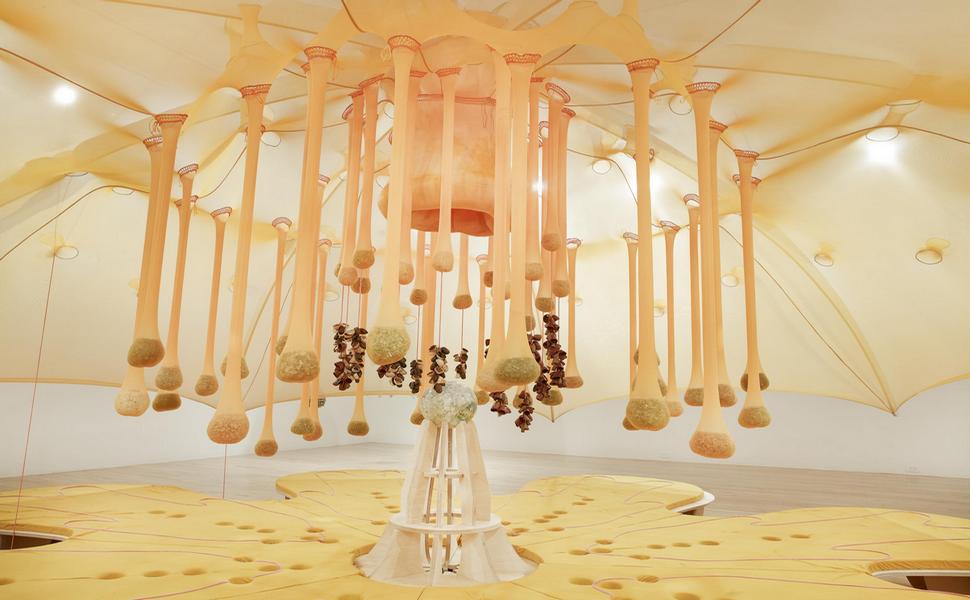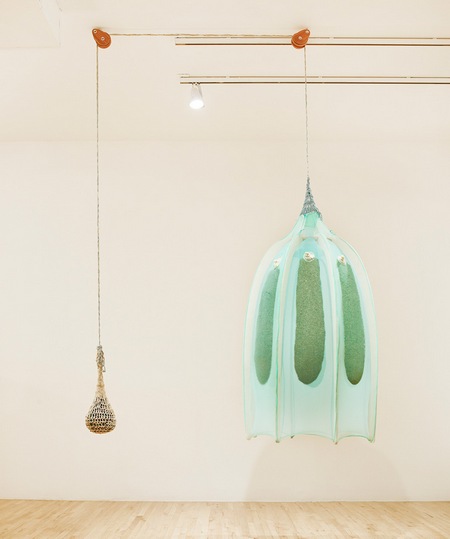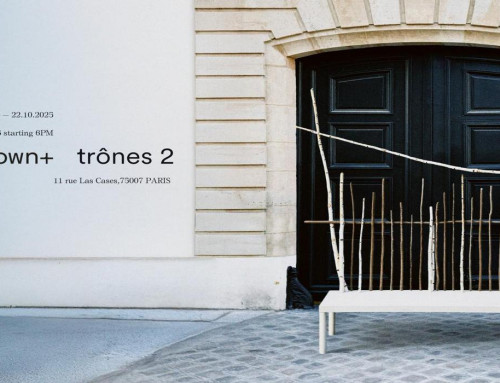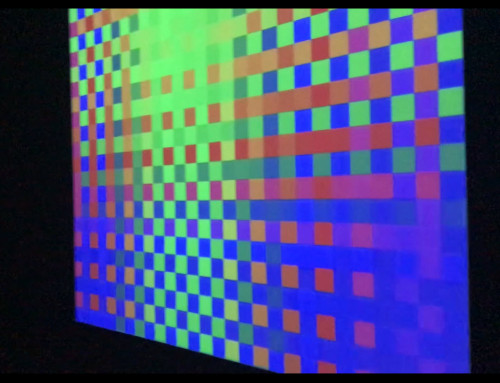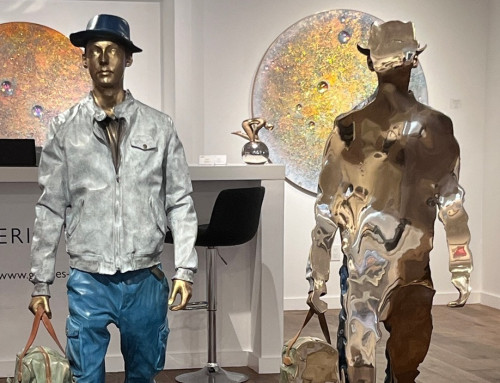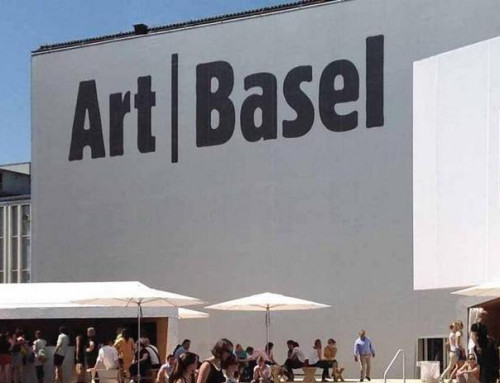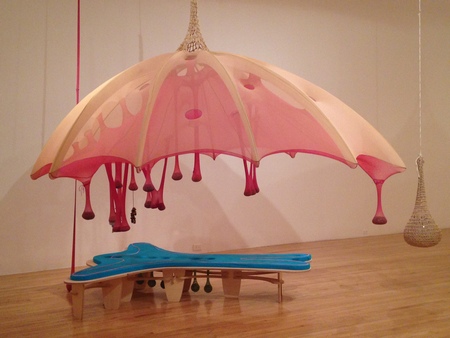
Egg Bed Crystal Shell, 2014
Plywood, cotton fabric, polyamide textile, polyurethane foam, semiprecious stones, and pulley
Life is for enjoyment and happiness.
To Ernesto Neto, one of the world’s leading contemporary artists, this is not just a statement about the purpose of life. This is what he does with his art work, which provides his viewers with an irresistible opportunity to literally experience joy and happiness.
People simply love his work: it’s not just the big crowds that show up in his exhibitions, either in the cold mountains of Aspen, Colorado, the hip New York scene, or the long established art forerunners in Europe or the Venice Biennale, or his more layback hometown in Rio de Janeiro. It is the big smiles reflected on his viewers’ faces and their enthusiasm to take active part in his large-scale, often room-size, interactive biomorphic works.
Imagine to find yourself in a place, where you can relax and experience with your senses- see, feel, touch, and even smell- shapes and colors that you do not understand and yet do not feel the need to know what it is, and then for a brief moment, begin to experience everything with a different perspective, to go beyond limitations in such a way that you could even begin to fantasize about creating your own universe.
Such is the ingenuity and serious playfulness that Neto has conveyed with his work.
In his exhibition last summer at the Aspen Art Museum, we found a work called “Flower Crystal Power”. In this work, you can actually lie down on a flower shaped bed, under a stretched dome to experience a virtual constellation of forms, textures, colors and scents around you.
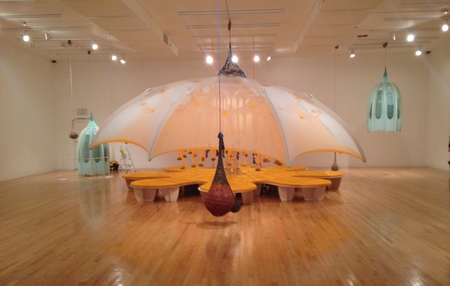
Flower Crystal Power, 2014
Plywood, cotton fabric, polyamide textile, polyurethane foam, semiprecious stones, and pulley.
Neto uses semi-transparent fabrics and hand-made crochets to contain elements, such as the crystals that he brought from Brazil and washed in Colorado’s Roaring Fork River, and suspends these forms in strategic places to represent “the seven chakras” or centers of energy in the human body.
The scents are also important to him, as Neto likes to regale his viewers with a wide variety of herbs and spices. In another sculpture “Capsule Seed”, for example, he uses seven distinct spices ranging from cinnamon to lavender.
Each of these stones emanates a different energy, each herb and spice has a different connection to the senses, and each color carries a symbolic value.
Neto investigates the interaction of the elements that he uses for his sculptures, and is more interested in the relationship between them rather than what separates them. His intention is to exert as little control over them as possible, and put them in a position that “you can let them be”, thus allowing them “to happen”.
It’s interesting to see that his focus on the issue of interactivity and collective sensory participation goes beyond his finished works and that it takes place even before the works are installed.
During one of his first visits to the Aspen Art Museum, as he was led to the empty space where his sculptures were to be installed, he lied down on the floor just to “imagine what he was going to do”; then the museum director lied down next to him, and then all the staff members working for the exhibition ended up lying down with him.
In another visit already very close to the opening date of his exhibition, he destroyed some of the crochets that had arrived at the museum because he did not like them. Then he asked a staff member to be involved directly in his work, by teaching her how to stitch crochets, and when she had finished, he told her that “you have made the most perfect crochets”.
He called his exhibition at the Aspen Art Museum, “Gratitude”. In his joy for life, he feels gratitude just to be alive, “to be able to smell and to breathe the huge spirituality that is living in this planet… to understand the power of this planet”.
“We are not here to suffer, even though suffering is part of life”, he says, “we are here to be happy, to dance, to sing”. To him we have created a world caught in a crazy race for productivity, and people are becoming slaves of it. “I want to tell them that they have the ability to change this world and make a new one: a world of exchange, respect, union and enjoyment”.
Somehow, and maybe for very brief moments, experiencing his art work which brings in soothing interactive, collective mood, one does get a glimpse on this world “of exchange, respect, union and enjoyment”.
And whether or not we have understood in those brief moments the power of this planet seems to have become irrelevant, as we know and distinctly remember all the fun we had and its promises, the colors, the smell, the feeling…Everything.
More about Ernesto Neto: http://inveroart.com/ernesto-neto-penny-w-stamps-lecture-at-uica/
*Image on slider: Ernesto Neto – Flower Crystal Power, 2014


